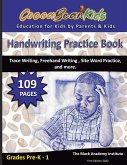- Gebundenes Buch
- Merkliste
- Auf die Merkliste
- Bewerten Bewerten
- Teilen
- Produkt teilen
- Produkterinnerung
- Produkterinnerung
Praise for the First Edition: `Sassoon presents her ideas in a direct and very practical style... a most significant and - even more importantly - a most usable book' - Primary and Middle School EquipmentThis essential book covers all aspects of handwriting from whole school planning to classroom management and from initial letter forms through to joined writing.
Andere Kunden interessierten sich auch für
![How to Develop Children's Early Literacy How to Develop Children's Early Literacy]() Laurie MakinHow to Develop Children's Early Literacy176,99 €
Laurie MakinHow to Develop Children's Early Literacy176,99 €![My Motivational Cursive Handwriting & Multiplication Workbook My Motivational Cursive Handwriting & Multiplication Workbook]() Denisha M BrownMy Motivational Cursive Handwriting & Multiplication Workbook33,99 €
Denisha M BrownMy Motivational Cursive Handwriting & Multiplication Workbook33,99 €![The Science Of Practical Penmanship The Science Of Practical Penmanship]() Thomas Pearce DolbearThe Science Of Practical Penmanship26,99 €
Thomas Pearce DolbearThe Science Of Practical Penmanship26,99 €![Handwriting Practice Book - Grades Pre-K - First Grade Handwriting Practice Book - Grades Pre-K - First Grade]() The Black Academy InstituteHandwriting Practice Book - Grades Pre-K - First Grade29,99 €
The Black Academy InstituteHandwriting Practice Book - Grades Pre-K - First Grade29,99 €![Esse & Friends Colouring and Handwriting Practice Workbook Girl Friends Esse & Friends Colouring and Handwriting Practice Workbook Girl Friends]() Esse & Friends Learning BooksEsse & Friends Colouring and Handwriting Practice Workbook Girl Friends16,99 €
Esse & Friends Learning BooksEsse & Friends Colouring and Handwriting Practice Workbook Girl Friends16,99 €![Cursive Handwriting Workbook For Adults Cursive Handwriting Workbook For Adults]() Life Daily StyleCursive Handwriting Workbook For Adults10,99 €
Life Daily StyleCursive Handwriting Workbook For Adults10,99 €![Children's Literature in the Classroom Children's Literature in the Classroom]() Matthew D. ZbarackiChildren's Literature in the Classroom160,99 €
Matthew D. ZbarackiChildren's Literature in the Classroom160,99 €-
-
-
Praise for the First Edition: `Sassoon presents her ideas in a direct and very practical style... a most significant and - even more importantly - a most usable book' - Primary and Middle School EquipmentThis essential book covers all aspects of handwriting from whole school planning to classroom management and from initial letter forms through to joined writing.
Hinweis: Dieser Artikel kann nur an eine deutsche Lieferadresse ausgeliefert werden.
Hinweis: Dieser Artikel kann nur an eine deutsche Lieferadresse ausgeliefert werden.
Produktdetails
- Produktdetails
- Verlag: SAGE Publications Ltd
- 2. Auflage
- Seitenzahl: 128
- Erscheinungstermin: 2. April 2003
- Englisch
- Abmessung: 250mm x 175mm x 12mm
- Gewicht: 414g
- ISBN-13: 9780761943105
- ISBN-10: 0761943102
- Artikelnr.: 21603108
- Herstellerkennzeichnung
- Libri GmbH
- Europaallee 1
- 36244 Bad Hersfeld
- gpsr@libri.de
- Verlag: SAGE Publications Ltd
- 2. Auflage
- Seitenzahl: 128
- Erscheinungstermin: 2. April 2003
- Englisch
- Abmessung: 250mm x 175mm x 12mm
- Gewicht: 414g
- ISBN-13: 9780761943105
- ISBN-10: 0761943102
- Artikelnr.: 21603108
- Herstellerkennzeichnung
- Libri GmbH
- Europaallee 1
- 36244 Bad Hersfeld
- gpsr@libri.de
Rosemary Sassoon is an independent consultant and lecturer, based in Sevenoaks, Kent. She is the author of Handwriting: The Way to Teach it, Paul Chapman Publishing, 2003.
PART ONE: PLANNING HANDWRITING ACROSS THE WHOLE SCHOOL
The Priority for Handwriting in the Curriculum
The Relationship between the Skill of Handwriting and Other Subjects
When to Introduce Handwriting in the Reception Class
The Choice of Handwriting Model
Balancing Movement and Neatness
How Much Emphasis on Joining
Display Writing - Both by Teachers and Pupils
Liaison with Pre-School Groups, Parents and Other Schools
A Policy for Left-Handers
A Policy for Special Needs
A Policy for Newcomers from Other Schools
Terminology
Assessment and Record Keeping
PART TWO: CLASSROOM MANAGEMENT
Layout of the Classroom
Balancing Whole-Class Instruction with One-to-One Attention
Posture
Appropriate Furniture
Paper Position and Its Effect on Posture
Penhold
Materials
Pencils and Pens, Paper Size and Lines
Making Children Aware of the Importance of All These Ideas
PART THREE: A SYSTEM FOR TEACHING LETTERS
The Vital Early Years
The Concepts Behind Our Writing System
Different Approaches to Teaching
Explaining the Act of Writing in a Logical Sequence
Introducing Letters in Stroke-Related Families
Teaching the First Letter Family
Teaching the Second Letter Family
Teaching the Round Letters
Complex Letters and Emerging Problems
Name Writing
Designing Exercises
Starting to Use Letters
Lines
Drawing with Writing
Remedial Work Often Begins on Day One
Joining as Soon as Possible
Personal Letters Lead to Efficiency and Speed
What Handwriting Problems May Indicate
Layouts for Practice Cards
Recommendations from Research into Children¿s Handwriting
Some Personal Comments
PART FOUR: A NEW WAY OF LOOKING AT HANDWRITING PROBLEMS
Handwriting as a Diagnostic Tool
Problems That Show through Handwriting
Specific Problems for Left-Handers
Problems with Directionality
Perceptual Problems
Observing, Assessing and Dealing with Tremors
Fatigue
Gaps in Learning
Posture as an Indicator, as Well as a Cause of Problems
An Attitude of Understanding
The Priority for Handwriting in the Curriculum
The Relationship between the Skill of Handwriting and Other Subjects
When to Introduce Handwriting in the Reception Class
The Choice of Handwriting Model
Balancing Movement and Neatness
How Much Emphasis on Joining
Display Writing - Both by Teachers and Pupils
Liaison with Pre-School Groups, Parents and Other Schools
A Policy for Left-Handers
A Policy for Special Needs
A Policy for Newcomers from Other Schools
Terminology
Assessment and Record Keeping
PART TWO: CLASSROOM MANAGEMENT
Layout of the Classroom
Balancing Whole-Class Instruction with One-to-One Attention
Posture
Appropriate Furniture
Paper Position and Its Effect on Posture
Penhold
Materials
Pencils and Pens, Paper Size and Lines
Making Children Aware of the Importance of All These Ideas
PART THREE: A SYSTEM FOR TEACHING LETTERS
The Vital Early Years
The Concepts Behind Our Writing System
Different Approaches to Teaching
Explaining the Act of Writing in a Logical Sequence
Introducing Letters in Stroke-Related Families
Teaching the First Letter Family
Teaching the Second Letter Family
Teaching the Round Letters
Complex Letters and Emerging Problems
Name Writing
Designing Exercises
Starting to Use Letters
Lines
Drawing with Writing
Remedial Work Often Begins on Day One
Joining as Soon as Possible
Personal Letters Lead to Efficiency and Speed
What Handwriting Problems May Indicate
Layouts for Practice Cards
Recommendations from Research into Children¿s Handwriting
Some Personal Comments
PART FOUR: A NEW WAY OF LOOKING AT HANDWRITING PROBLEMS
Handwriting as a Diagnostic Tool
Problems That Show through Handwriting
Specific Problems for Left-Handers
Problems with Directionality
Perceptual Problems
Observing, Assessing and Dealing with Tremors
Fatigue
Gaps in Learning
Posture as an Indicator, as Well as a Cause of Problems
An Attitude of Understanding
PART ONE: PLANNING HANDWRITING ACROSS THE WHOLE SCHOOL
The Priority for Handwriting in the Curriculum
The Relationship between the Skill of Handwriting and Other Subjects
When to Introduce Handwriting in the Reception Class
The Choice of Handwriting Model
Balancing Movement and Neatness
How Much Emphasis on Joining
Display Writing - Both by Teachers and Pupils
Liaison with Pre-School Groups, Parents and Other Schools
A Policy for Left-Handers
A Policy for Special Needs
A Policy for Newcomers from Other Schools
Terminology
Assessment and Record Keeping
PART TWO: CLASSROOM MANAGEMENT
Layout of the Classroom
Balancing Whole-Class Instruction with One-to-One Attention
Posture
Appropriate Furniture
Paper Position and Its Effect on Posture
Penhold
Materials
Pencils and Pens, Paper Size and Lines
Making Children Aware of the Importance of All These Ideas
PART THREE: A SYSTEM FOR TEACHING LETTERS
The Vital Early Years
The Concepts Behind Our Writing System
Different Approaches to Teaching
Explaining the Act of Writing in a Logical Sequence
Introducing Letters in Stroke-Related Families
Teaching the First Letter Family
Teaching the Second Letter Family
Teaching the Round Letters
Complex Letters and Emerging Problems
Name Writing
Designing Exercises
Starting to Use Letters
Lines
Drawing with Writing
Remedial Work Often Begins on Day One
Joining as Soon as Possible
Personal Letters Lead to Efficiency and Speed
What Handwriting Problems May Indicate
Layouts for Practice Cards
Recommendations from Research into Children¿s Handwriting
Some Personal Comments
PART FOUR: A NEW WAY OF LOOKING AT HANDWRITING PROBLEMS
Handwriting as a Diagnostic Tool
Problems That Show through Handwriting
Specific Problems for Left-Handers
Problems with Directionality
Perceptual Problems
Observing, Assessing and Dealing with Tremors
Fatigue
Gaps in Learning
Posture as an Indicator, as Well as a Cause of Problems
An Attitude of Understanding
The Priority for Handwriting in the Curriculum
The Relationship between the Skill of Handwriting and Other Subjects
When to Introduce Handwriting in the Reception Class
The Choice of Handwriting Model
Balancing Movement and Neatness
How Much Emphasis on Joining
Display Writing - Both by Teachers and Pupils
Liaison with Pre-School Groups, Parents and Other Schools
A Policy for Left-Handers
A Policy for Special Needs
A Policy for Newcomers from Other Schools
Terminology
Assessment and Record Keeping
PART TWO: CLASSROOM MANAGEMENT
Layout of the Classroom
Balancing Whole-Class Instruction with One-to-One Attention
Posture
Appropriate Furniture
Paper Position and Its Effect on Posture
Penhold
Materials
Pencils and Pens, Paper Size and Lines
Making Children Aware of the Importance of All These Ideas
PART THREE: A SYSTEM FOR TEACHING LETTERS
The Vital Early Years
The Concepts Behind Our Writing System
Different Approaches to Teaching
Explaining the Act of Writing in a Logical Sequence
Introducing Letters in Stroke-Related Families
Teaching the First Letter Family
Teaching the Second Letter Family
Teaching the Round Letters
Complex Letters and Emerging Problems
Name Writing
Designing Exercises
Starting to Use Letters
Lines
Drawing with Writing
Remedial Work Often Begins on Day One
Joining as Soon as Possible
Personal Letters Lead to Efficiency and Speed
What Handwriting Problems May Indicate
Layouts for Practice Cards
Recommendations from Research into Children¿s Handwriting
Some Personal Comments
PART FOUR: A NEW WAY OF LOOKING AT HANDWRITING PROBLEMS
Handwriting as a Diagnostic Tool
Problems That Show through Handwriting
Specific Problems for Left-Handers
Problems with Directionality
Perceptual Problems
Observing, Assessing and Dealing with Tremors
Fatigue
Gaps in Learning
Posture as an Indicator, as Well as a Cause of Problems
An Attitude of Understanding








